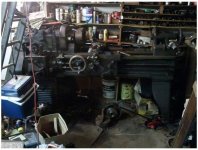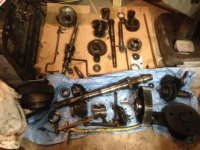chubbyjp77
Plastic
- Joined
- Jul 18, 2016
I posted to an old thread earlier and figured I should start one the right way. At least all the info will be at the same place.
I bought a Cincinnati Lathe and tool 16x48 geared head lathe recently. The number stamped on the bed is 3053. I got it cheap ($500) locally and figured it would be a decent place to start. It has proven quite hard to find info on it so far. So any ideas on manuals or anything would be great.
I finally have the lathe connected to my RPC and it runs but I can't quite figure out the hand wheels on the carriage. I understand the QC gear box and the knob that selects the shaft or lead screw along with the half nuts and directional control but the hand wheels have me a bit baffled. They rotate when the direction lever is engaged but i can't get them to drive the carriage or cross feed. Does anyone know how the work? The lathe sat for awhile so the more info I have the better I know what needs attention.
I have an oil change and thorough cleaning lined up in the near future but don't want to waste oil on something that needs torn apart later. I'm going to remove the top for inspection and cleaning of the headstock and I'm going to clean the external gears and relube them. Any suggestions on lubricant for these areas? The headstock, QC box, and apron should be fine with Mobil DTE Medium which I bought a 5 gallon pail of but the gears and chain I'm uncertain of.
Any help on the use, age, model, and proper lubricants for this machine would be a great help. It's seems to be a well built machine and I think it deserves some attention to try and keep functional for years to come. Thanks in advance for any ideas and help.
I bought a Cincinnati Lathe and tool 16x48 geared head lathe recently. The number stamped on the bed is 3053. I got it cheap ($500) locally and figured it would be a decent place to start. It has proven quite hard to find info on it so far. So any ideas on manuals or anything would be great.
I finally have the lathe connected to my RPC and it runs but I can't quite figure out the hand wheels on the carriage. I understand the QC gear box and the knob that selects the shaft or lead screw along with the half nuts and directional control but the hand wheels have me a bit baffled. They rotate when the direction lever is engaged but i can't get them to drive the carriage or cross feed. Does anyone know how the work? The lathe sat for awhile so the more info I have the better I know what needs attention.
I have an oil change and thorough cleaning lined up in the near future but don't want to waste oil on something that needs torn apart later. I'm going to remove the top for inspection and cleaning of the headstock and I'm going to clean the external gears and relube them. Any suggestions on lubricant for these areas? The headstock, QC box, and apron should be fine with Mobil DTE Medium which I bought a 5 gallon pail of but the gears and chain I'm uncertain of.
Any help on the use, age, model, and proper lubricants for this machine would be a great help. It's seems to be a well built machine and I think it deserves some attention to try and keep functional for years to come. Thanks in advance for any ideas and help.







